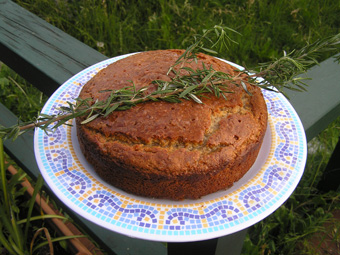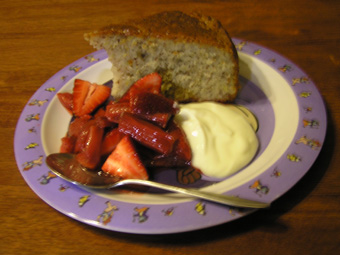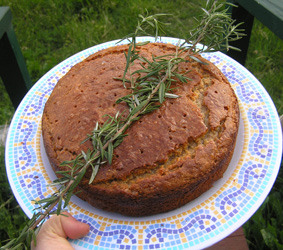 Brunswick and Coburg, the suburbs in which I have lived most of my adult life, were both settled from the 1950s onward by working class immigrants from Italy, Greece, Turkey and other parts of the Mediterranean. The proof of this is in the architecture (lots of brown brick, pillars, lion statues, and yellow glass windows – though also enormous kitchens, and often an extra kitchen in the garage) and in the back gardens, which tend to be full of vegetables and fruit trees. Sometimes, the front gardens are also planted full of vegetables, all in neat rows and shaded from the heat of summer by carefully draped sheets.
Brunswick and Coburg, the suburbs in which I have lived most of my adult life, were both settled from the 1950s onward by working class immigrants from Italy, Greece, Turkey and other parts of the Mediterranean. The proof of this is in the architecture (lots of brown brick, pillars, lion statues, and yellow glass windows – though also enormous kitchens, and often an extra kitchen in the garage) and in the back gardens, which tend to be full of vegetables and fruit trees. Sometimes, the front gardens are also planted full of vegetables, all in neat rows and shaded from the heat of summer by carefully draped sheets.
Of course, not everyone has time to grow vegetables. And some people have moved out of their Italian palazzi and left the garden to less-motivated Anglo buyers. But there are a few hardy Mediterranean plants which, though they may not be found in every Coburg or Brunswick garden, are found in so many of them that one is surprised to see a garden without any.
Olive trees are the first of these. We don’t have one ourselves, but our neighbours do. I think, actually, our neighbours on both sides have them. Lavender is another very popular Coburg choice. It may not be Mediterranean but it does seem to turn up a lot in Mediterranean gardens of the Melbourne kind. Rosemary, of course, is vital. You see it in hedges (you see lavender hedges too, but much less often), and in herb patches and as groundcover. Rosemary loves the Australian climate and is virtually unkillable here. There is a lot of rosemary in Coburg.
Last, and most iconic of all, is the lemon tree. Everybody has one. You don’t need much space for it, and you can use lemons in everything. When I was househunting, even the tiniest gardens and the gardens owned by people who clearly weren’t that interested in gardening had, as a minimum, a stretch of lawn with a lemon tree out the front and a clothesline out the back. You mightn’t grow anything else, but you grew lemons.
I’d be hard pressed to think of a house I’ve seen in my area that didn’t have at least one of these bushes or trees. Most have two or three of them. We have everything except the olives (we make up for the lack of olives with self-sown fig trees). This cake, then, is the essence of Coburg gardens. It tastes like our garden smells in summer, of lemons, lavender and rosemary, with a hint of olive oil in the background. It’s dense and sweet and aromatic and full of yoghurt and ground almonds (two more very Coburg ingredients), so it will keep for days. I’m actually really proud of this cake – it’s based on a Diana Henry recipe (for rose and lime syrup cake), but the flavour profile is utterly different – completely unrecognisable.
Also, it’s dead easy to make.
Your Shopping List
zest and juice of 1 1/2 good-sized lemons, preferably from someone’s back yard 175 g + 150 g caster sugar 275 ml water 3 small sprigs of fresh rosemary 200g self-raising flour 115 g ground almonds (the coarse type which still have some of the skins are good here) 1 – 1 1/2 tsp dried lavender, pounded in a mortar and pestle (or a teaspoon of lavender water, or replace some of the sugar with lavender sugar) 1 tsp baking powder pinch of salt 2 large eggs 250 ml Greek yoghurt 150 ml olive oil
Now what will you do with it?
Start by zesting your lemons, and putting the zest into a small bowl. You actually need the juice first, but if you’ve ever tried to zest a lemon that you’ve already juiced you will know exactly why I don’t recommend this course of action.
Preheat the oven to 180°C and line the bottom of a 20cm round springform tin with baking paper.
Juice the lemons and put into a small saucepan with the water, rosemary sprigs and 175 g of the sugar. Put over a very low heat and stir occasionally until the sugar has dissolved (you can prepare most of the cake while this is happening). Bring to the boil and then let simmer on a very low heat for at least ten minutes. Switch off the heat and let the rosemary continue to infuse the syrup while the cake is cooking.
Put the flour, almond meal, sugar, baking powder, salt, and dried lavender in a bowl, and stir together.
Put the yoghurt, olive oil and eggs into the bowl that has the lemon zest in it, and beat until smooth. If you were using lavender water rather than dried lavender, you would add it to the wet ingredients, not the dry ones.
Quickly beat your wet ingredients into your dry ingredients until they are well mixed and smooth. Scrape into the prepared tin and bake for about 45 minutes or until the cake passes the skewer test.
Remove the cake from the oven and let cool 10 minutes in the pan before turning it out onto a plate (this sounds as though the cake will be up-side down. It shouldn’t be. Turn it out onto a plate, then put another plate on top and turn it onto that one. Surely you don’t need me to tell you this? I can feel you looking at me quizzically now…). Prick all over with a skewer.
Remove the rosemary sprigs from the syrup, and pour the syrup bit by bit over the cake – I pour a little, let it be absorbed, pour a little more, and so forth, until it’s done. It takes less time than you think, and the cake certainly can absorb all the syrup.
Serve warm or at room temperature with unsweetened Greek yoghurt and berries or stewed rhubarb.
Be transported to Coburg (and not in the old-fashioned sense with hard labour and chains and hulks)!
Variations
The original recipe uses the juice and zest of two limes, no lavender, lemons or rosemary, and adds a teaspoon of rosewater while the syrup is cooling. It’s very good, too!
I think this could adapt quite well into a flourless cake. I’d increase the ground almonds to 250g and add 60g of polenta and an extra egg, as well as an extra teaspoon of baking powder. The cake would be denser and richer, but I think it would still be rather good. Of course, you could also replace the self-raising flour with a gluten-free mix and a teaspoon of baking powder, and this would be more reliable (but less adventurous!).
Veganising this might be a bit harder, because the eggs are pretty important. Soy yoghurt would certainly be fine to replace the Greek yoghurt (but try to find an unflavoured one if you can – I know this is hard in Australia) for a dairy-free cake, but I’m just not sure about the best egg-replacey option here. Apple sauce and an extra bit of baking powder might be nice and would fit the garden theme. I suspect you could get away with the linseed egg replacer here because the flavours are strong enough to cover any linseed taste.
Making this cake nut free would be pretty much making a different cake, but I’d be inclined to replace the nuts with semolina or polenta, to get that interesting dense texture.
Just eat the yummy Coburg Garden Cake, that’s my advice…



4 comments for “Recipe: Coburg Garden Cake”